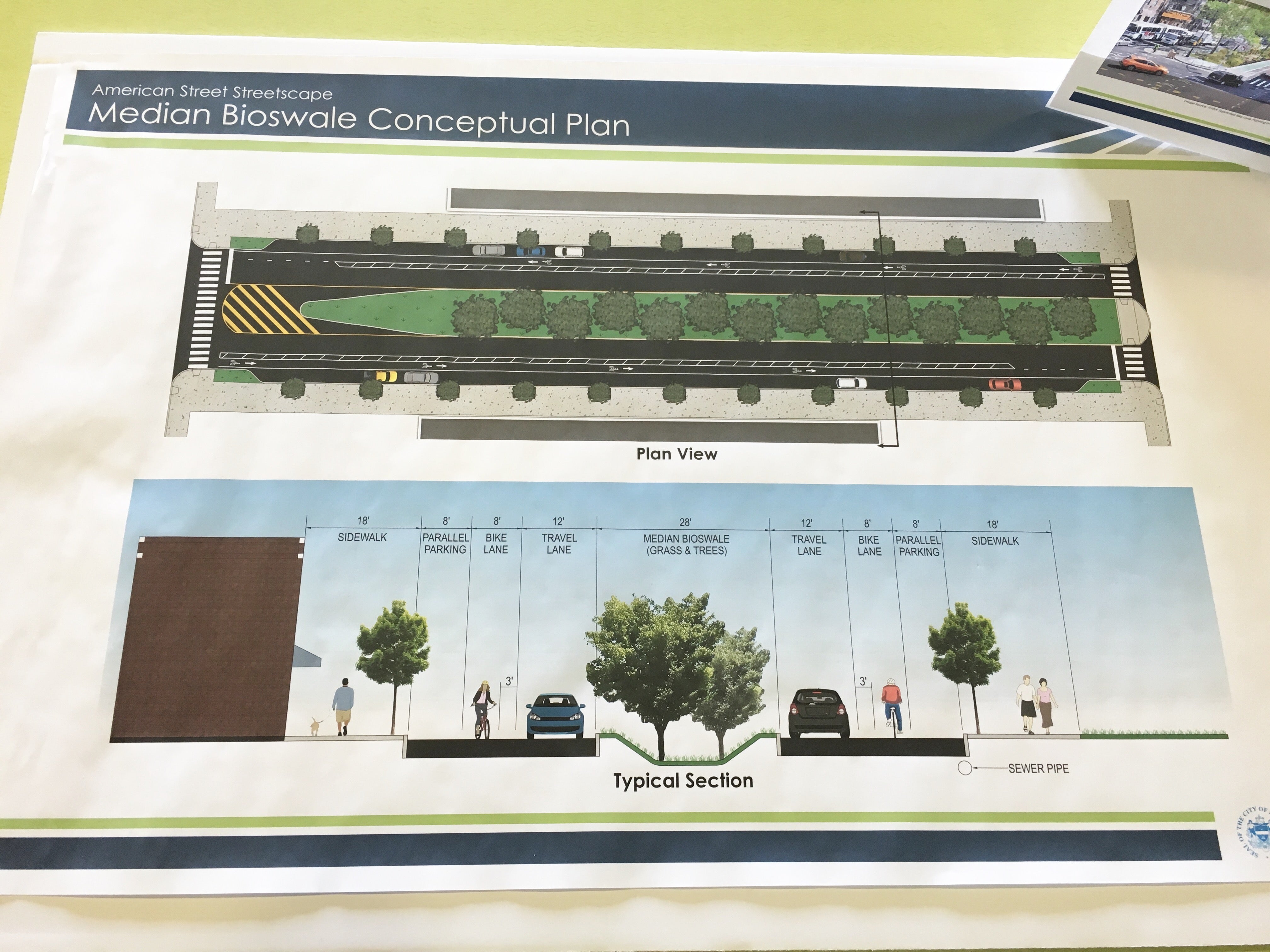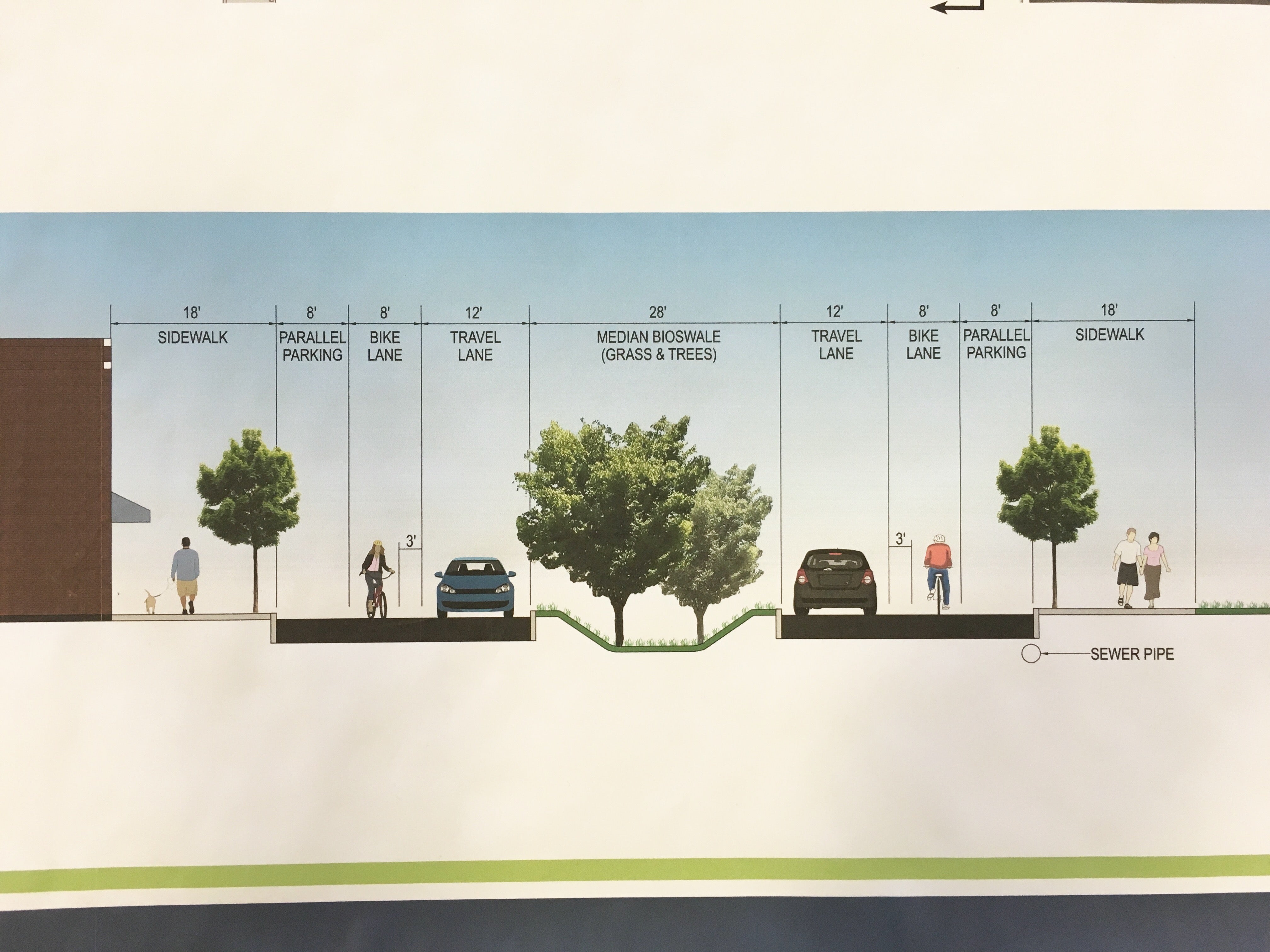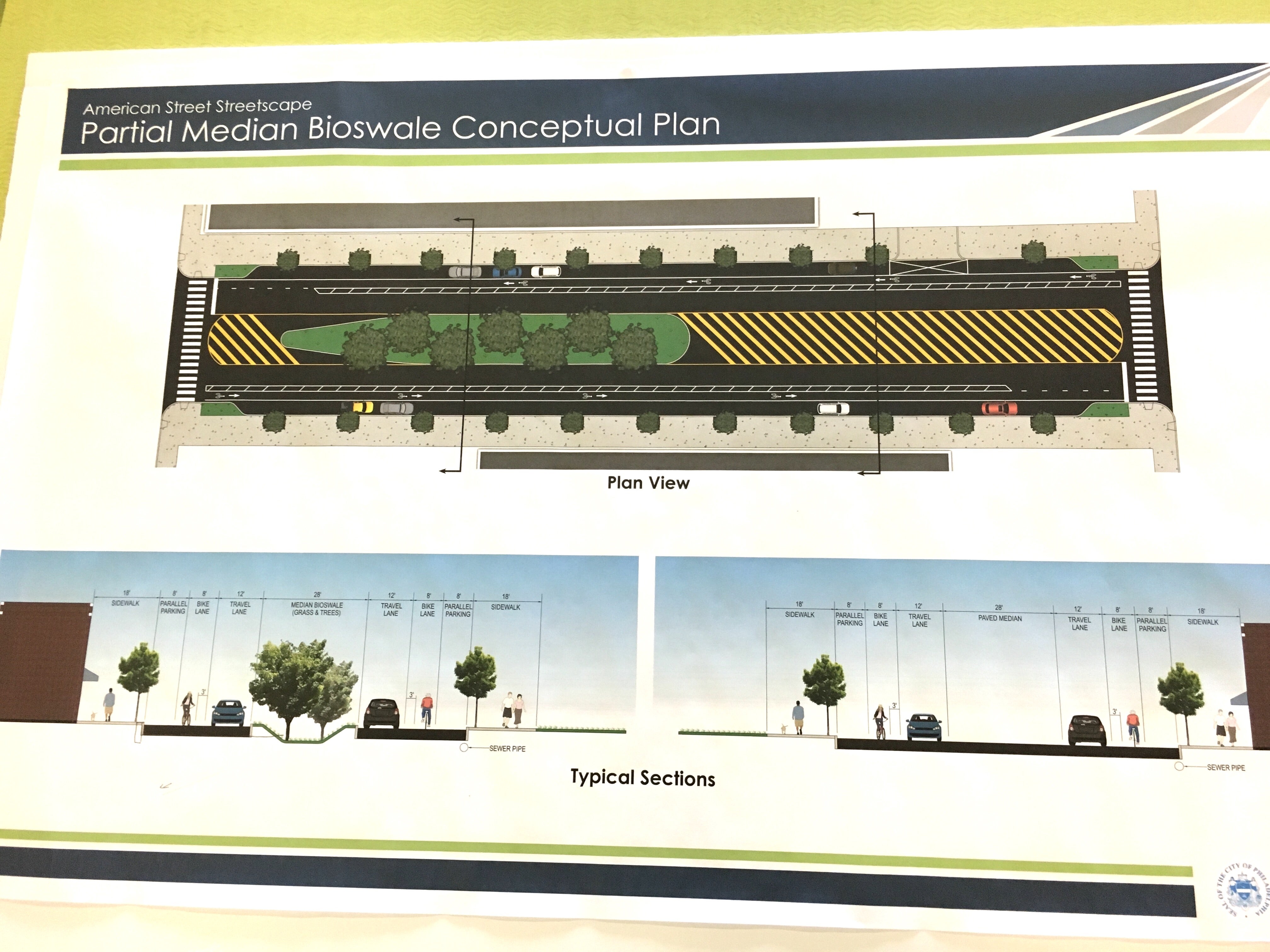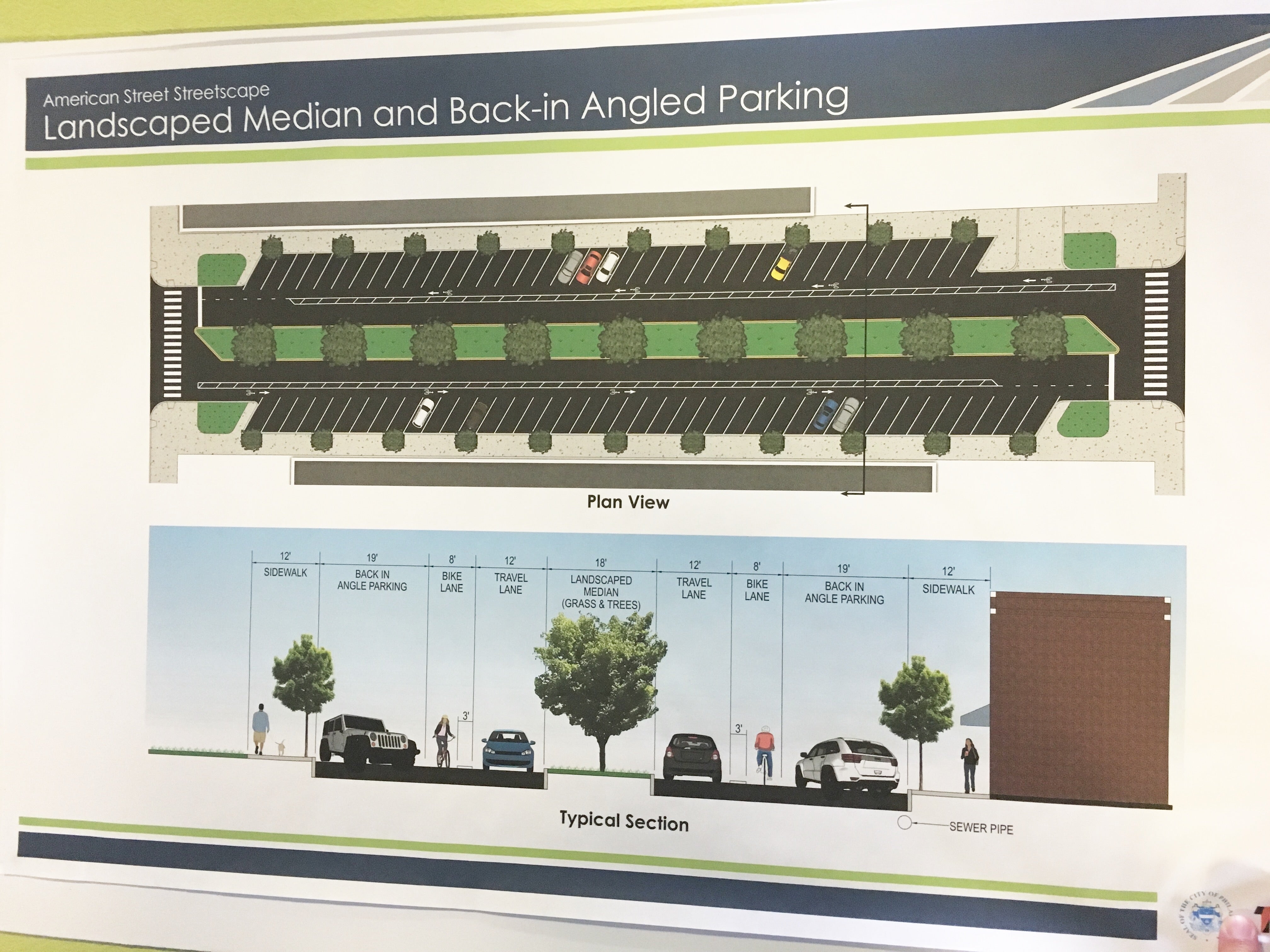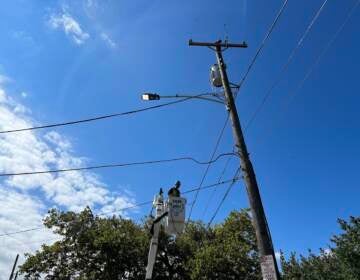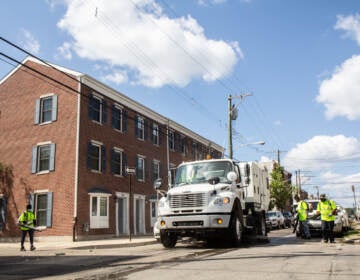City advances redesign for North American Street, including 28-foot wide bioswale
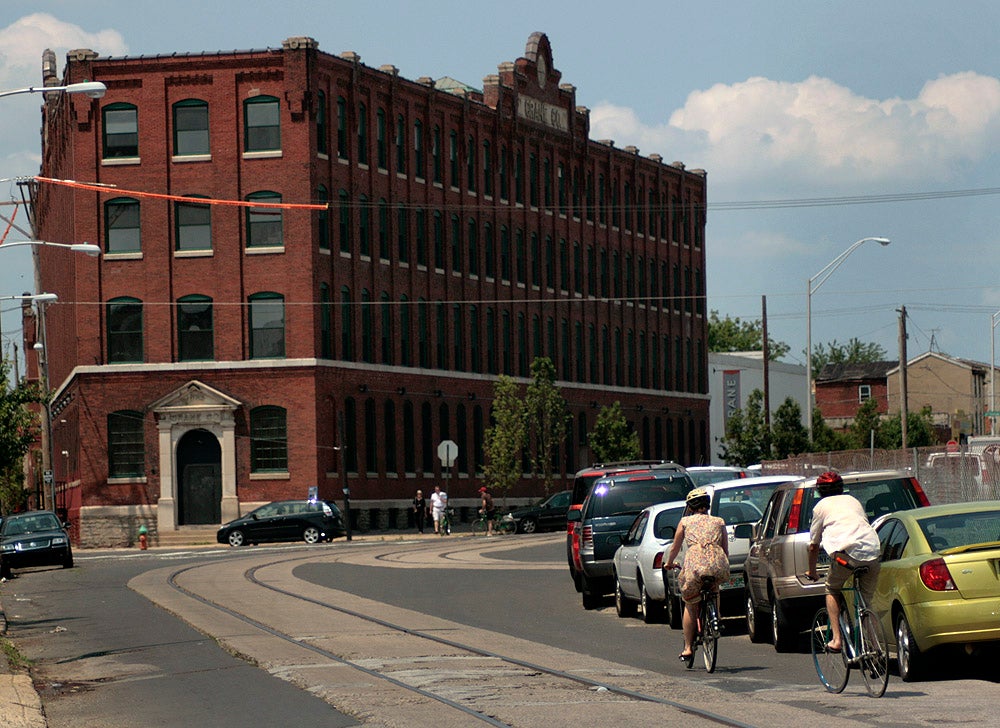
North American Street could become the city’s premiere example of a green street, using the road’s expansive width to soak up stormwater with a 28-foot wide bioswale running up the center median.
As PlanPhilly reported last fall, the City was awarded $10.2 million in federal TIGER grants, $5 million of which would go towards remaking two miles of American Street north of Girard Avenue. Plans include removing the rail tracks running down the center of American Street and adding bike lanes, new sidewalks, incorporating green infrastructure tools to manage stormwater. The project is projected to cost $17.4 million.
Redesigning American Street has been on the agenda for multiple city departments for many different reasons for more than a decade, but until recently, the stars hadn’t aligned to pull it off.
An earlier plan to remove the rail tracks was on the Delaware Valley Regional Planning Commission’s Transportation Improvement Program (TIP) project list ten years ago, but was then removed as other projects eclipsed it in priority. The newer more robust version of the project, which was added back to the TIP two years ago, includes a green stormwater component and “complete streets” features like bike lanes and wider sidewalks.
“The Water Department has been interested in this area for a long time,” said Ariel Ben-Amos, a planner with the Water Department, “The street itself is 22 acres of impervious surface within the right-of-way alone, and you have a lot of businesses that have large rooftops.”
At the first of two public open houses about the project, held last week at Congreso, representatives from the Streets, Commerce, and Philadelphia Water departments presented several early design concepts to residents and businesses and gathered feedback for the redesign. There were six tables, each devoted to a different segment of the study area, where attendees could weigh in on the concepts. (As multiple planners stressed, these are not yet “recommendations.”)
The proposed street design changes vary based on the land uses nearby, but a basic pattern held along most of the corridor: a 28-foot bioswale in the median for collecting stormwater, a lane reduction to one 12-foot travel lane in each direction, and some combination of a bike lane, parking lanes, and wider sidewalks. Blocks with more driveways or loading needs were given smaller medians, and the area of the northern side closest to the Lehigh Avenue shopping centers had back-in angle parking.
There will be a second public open house on Tuesday, July 26, at Crane Arts (1400 N. American St.) from 4:00 p.m. to 8:00 p.m., which will cover the same issues as presented during last week’s meeting at Congreso.
Currently, this part of American Street is the spine of an industrial zone running from Girard Avenue up to Indiana Avenue in North Philadelphia. The 36-foot lanes function informally as two 18-foot wide travel lanes in each direction, but are not striped as such.
Similar to Washington Avenue in South Philadelphia, American Street has been having a bit of an identity crisis.
American Street is in both an Enterprise Zone and a Keystone Opportunity Zone, which confer special tax breaks on area businesses and landowners. It is primarily industrial in character, and the Commerce Department and local elected officials remain committed to keeping it that way.
On its southern end in South Kensington, rising land values spilling over from Northern Liberties and East Kensington have contributed to increasing residential development interest in areas zoned industrial (I-2). Residential developments pursued using zoning variances at properties with industrial zoning can pack in extra units because of the more generous height and reduced setbacks that come with industrial zoning. A zoning remapping bill for the southern end of American Street that was presented to the Planning Commission recently was extended as negotiations continue between Councilwoman Maria Quiñones-Sánchez and neighbors.
Most of the comments from the 40 or so neighbors who cycled through last week’s meeting at Congreso touched on American Street’s safety and appearance. Complaints included reckless driving, faded crossings and illegal parking, as well as the street’s lack of tree cover, and problems with illegal dumping.
Most comments appeared to be generally in favor of the types of changes planners had in mind, though some were skeptical the changes would work, or that their impact would be positive. Neighbors generally agreed that American Street could be more neighborhood-friendly, with cleaner streets and more controlled traffic.
Barbara Carroll, a neighbor who lives by 6th and Lehigh, near the northern end of the project area, said many of the design concepts seemed like a good thing, but that she wasn’t yet sold on reducing the number of lanes.
“I just had some concerns about narrowing the street and limiting the lanes on American Street, especially down toward the southern end,” she said, “You don’t want to have a truck stopped trying to make a turn and holding up traffic. Because even right up here where the state [liquor] store is, all it would take is two trucks stopped to back it up all the way. “
Carroll also didn’t think the street was unsafe to walk across in its current state, at least at the crosswalks, and she wasn’t sure about the best place for new bike lanes.
“I don’t know if the safest thing is to have the bike lanes to the right of the car lanes, or to the left, where the drivers can see them,” she said, “Drivers aren’t looking for somebody over on that side.”
Planners had offered a few different options, with bike lanes hugging the green median in the center, between the travel lane and a row of back-in angle parking, as well as a few physically protected options.
Dana Hanchin, deputy director of the Local Initiatives Support Corporation (LISC), said the TIGER grant was an important opportunity to reconceive American Street “not as a divide but as a connector” and linking neighborhoods on either side through public space improvements.
“We have to look at where there are challenges with safety, not just for pedestrians crossing, but for vehicles as well, and how design can improve safety overall.”
WHYY is your source for fact-based, in-depth journalism and information. As a nonprofit organization, we rely on financial support from readers like you. Please give today.



